(Written by William)
When I first heard rumors that the #10294 LEGO Creator Expert Titanic was not only going to be a thing, but also that it was going to be the largest model ever sold, I was in shock. Keep in mind, I had built the massive #75192 LEGO Star Wars Millennium Falcon and I knew that the #31203 LEGO Art World Map had an insane number of parts. It was still boggling my mind just how big this ship would be.
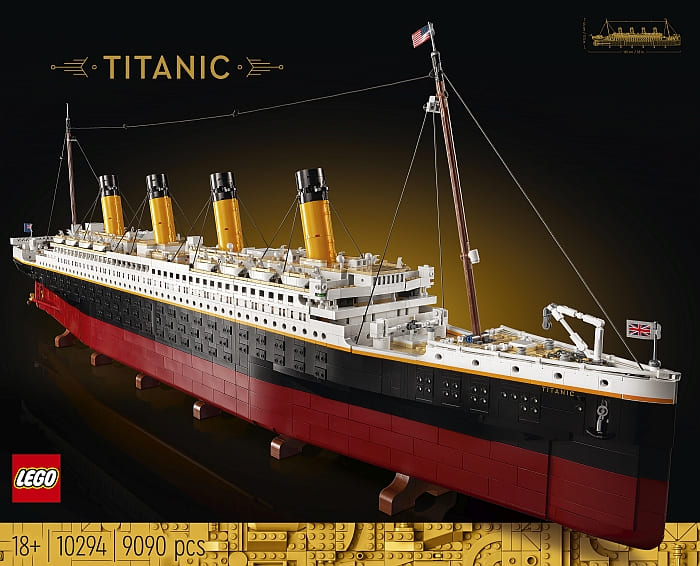
So when I was offered the set for review, I immediately said yes. Then I had to figure out what I’d tell my wife when it came. She helps me build every model and the Falcon nearly killed us. Thankfully, the Titanic had some saving graces.
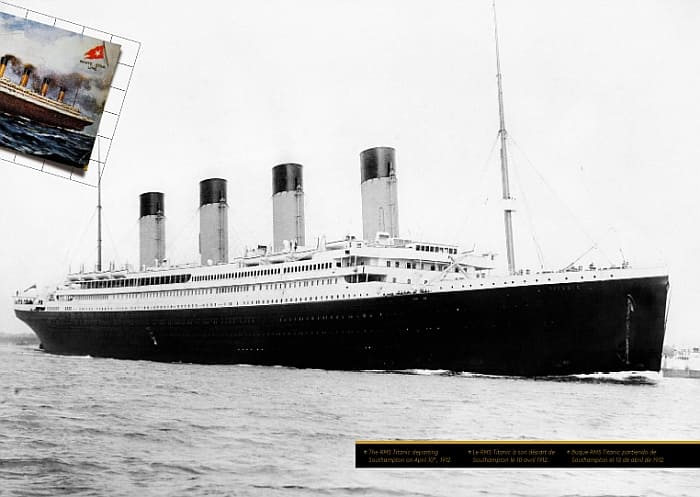
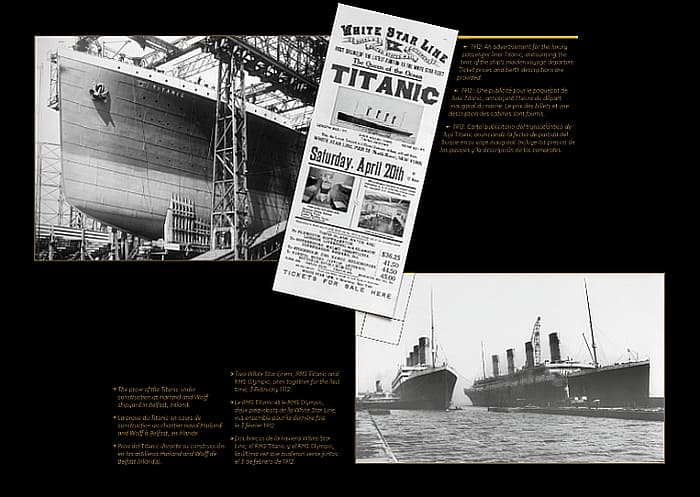
The first of these was that it has 9,090 parts. Sure, the #31203 LEGO Art World Map has more pieces (11,695), but that is more or less a massive canvas. The ship is a three-dimensional model, so they are classified slightly differently.
The second saving grace was that the Titanic is more compact and down to earth. What I mean is that the set is heavily compartmentalized, plus, as you build, you immediately know what you’re working on. Compared to the Millennium Falcon where we were constantly out of our depth.
The Falcon had so many exotic shapes and angles that you weren’t totally sure what you were working on at any given time. Being able to build and recognize elements of a ship turned out to be very mentally rewarding, making it more pleasurable to assemble the Titanic.
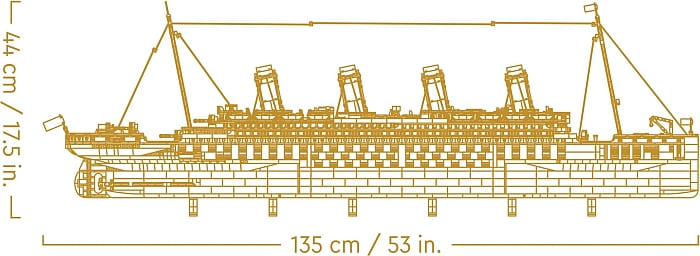
As for the compartmentalization, I’ve never had a model so well sorted as this. Right out of the main box there are three numbered separate boxes that clearly show what you can expect. Each box is decorated with a picture of what is being built and each box has its own instruction manual. This level of organization leads to a style of building I’ve never really thought to advocate for. So, let’s dig in and talk about that style and introduce the concept of communal building in an official LEGO set.
LEGO TITANIC – COMMUNAL BUILDING
I’ve had the opportunity to build a set of this size before. However, the Titanic has a very different aspect to it I wasn’t expecting. Based on the way LEGO has organized the set, this model is ideal for communal building. In short, having three interior boxes each self-contained with their own parts and instructions for a given section of the ship, you can immediately have three independent groups working on the model at the same time.
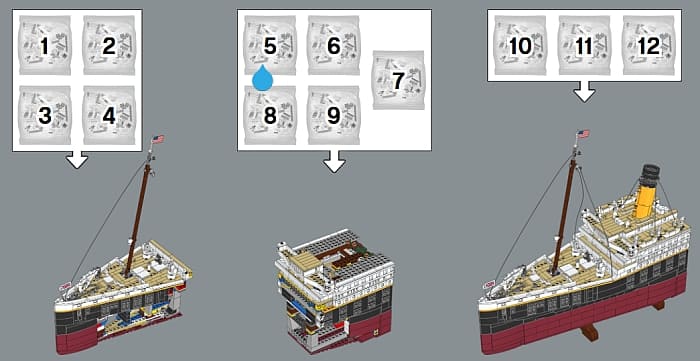
This style of organization is fairly new. Though I will point out it was found in the #43179 LEGO Disney Mickey Mouse and Minnie Mouse Buildable Characters released in 2019. In that set, two groups could take a set of parts and instructions and work on either statue at the same time. Compare this to say, the Millennium Falcon which has a massive instruction book that is hard to share and a total of 17 numbered bag steps, the Falcon makes a poor choice for sharing. And that leads to something interesting.
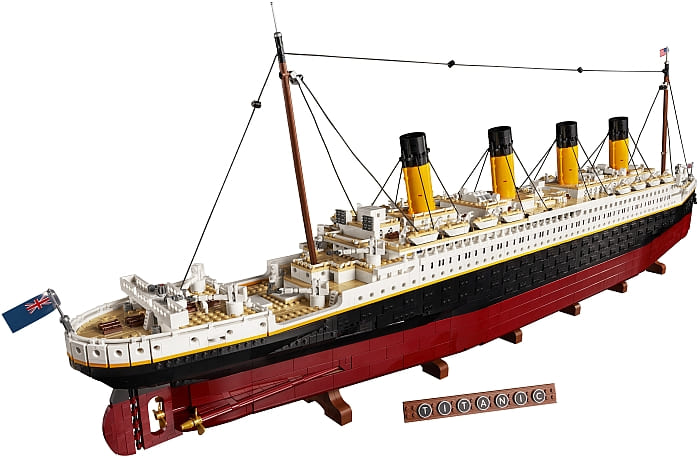
When brick conventions feature a speed-build, they enjoy having the challenge of building something difficult. The Titanic is ready-made to make speed building easier. Therefore, I can see many conventions still favoring the Falcon due to its higher level of complexity.
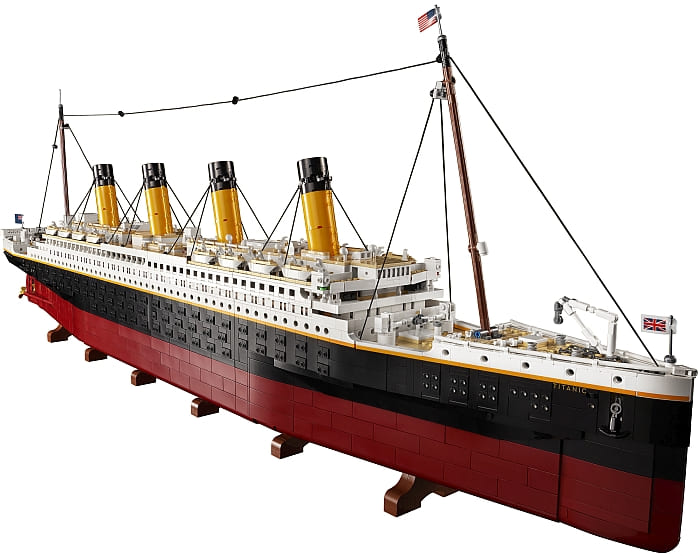
The complexity level is also interesting to see lowered. One of the main points LEGO has been making when it comes to their 18+ sets is that they are ideal for relaxation. I’ll speak a bit more in-depth on this when it comes to the building experience, but in general, the Titanic is a fantastic family project. Stress is set relatively low and you can have different family members work together on different sections if you still want a slightly solo building experience.
I’d also advocate for LEGO User Groups (LUGs), to maybe consider having one of these models as club property. It is noteworthy for displays and, as mentioned above, works fantastic for a communal club build.
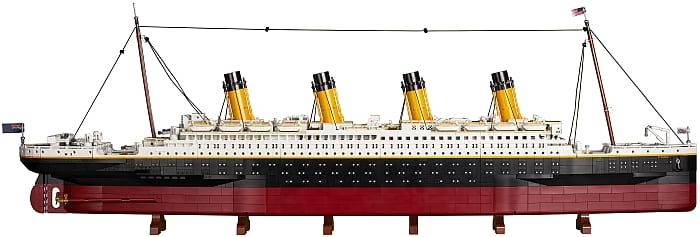
If you are at all concerned with skill level when it comes to building, here is my suggestion. Give the most novice builder the middle of the ship. Your more advanced builder can tackle the front of the ship. And leave your expert builder the back end. Each stage is not terribly different, rather the front does have a few more challenging elements when it comes to shaping the hull. Meanwhile, the stern not only has a special hull shape but also features working pistons. This means some of the connection points may feel a bit more exotic in nature.
LEGO TITANIC – BUILDING EXPERIENCE
I’ve been trying to get my hands on as many recent adult-themed sets as I can. The finished results are usually stunning and the builds are remarkably relaxing. With that in mind, I tried not to rush my building of the Titanic and instead worked at it as if it were a long-term hobby project.
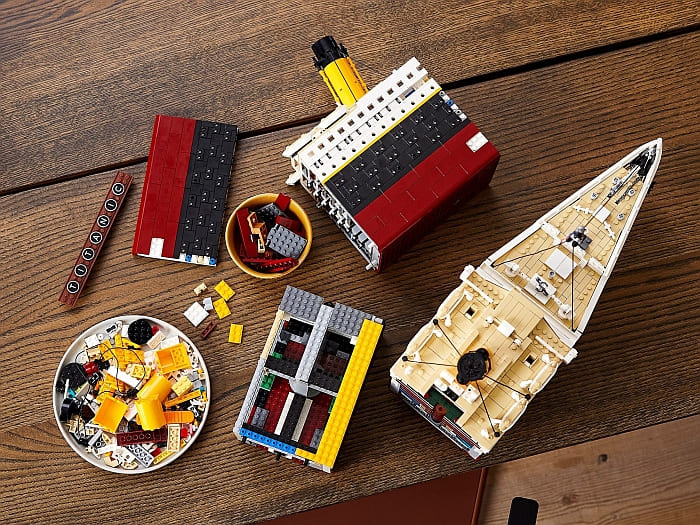
My wife and I would spend a couple hours each evening working on the ship. On average, we’d complete around two numbered bag steps each sitting. At this pace, it took around a week’s worth of evenings to complete a third of the ship. I’d say straight building time at a leisurely speed put the actual build hours in between 42 and 52 hours.
As for what you build, the model gives me the same experience as one of the large world monument builds. There are a lot of small parts that will repeat in a number of areas. However, unlike a world monument building, there are very interesting challenges and build techniques to experience because the Titanic is a ship. For starters, you have a moving rudder and propellors, but the real treat is the hull.
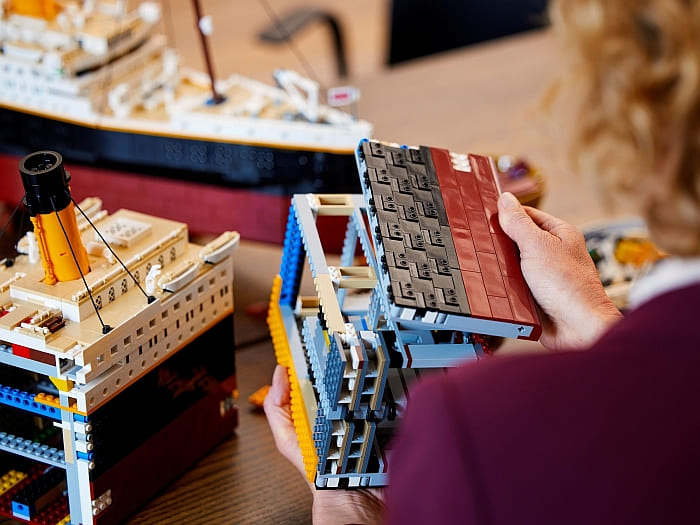
Shaping the superstructure to allow the hull to taper down was extremely satisfying to see come together. Additionally, the interior cross-sections of the ship as well as the detailing on the deck allow for some very precise part usage. The deck especially is a treat to assemble. After all, each part of the ship has a unique function and purpose. Whether it be cranes, a promenade, or a skylight, it adds a great deal of variety as to what happens on top of the ship.
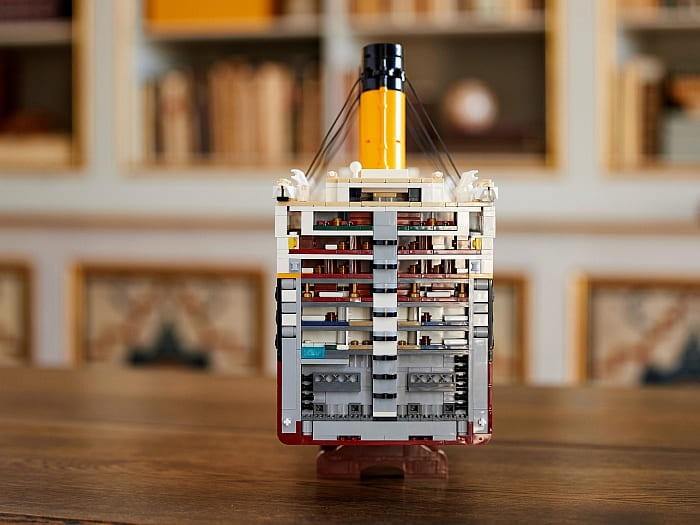
And despite all the intricate details and small parts, I found the build remarkably relaxing to put together. LEGO designers have gone out of their way not to overwhelm you with building the set. It has been divided down into 46 numbered bags, which are further divided into three separate boxes. But the compartmentalization doesn’t stop there.
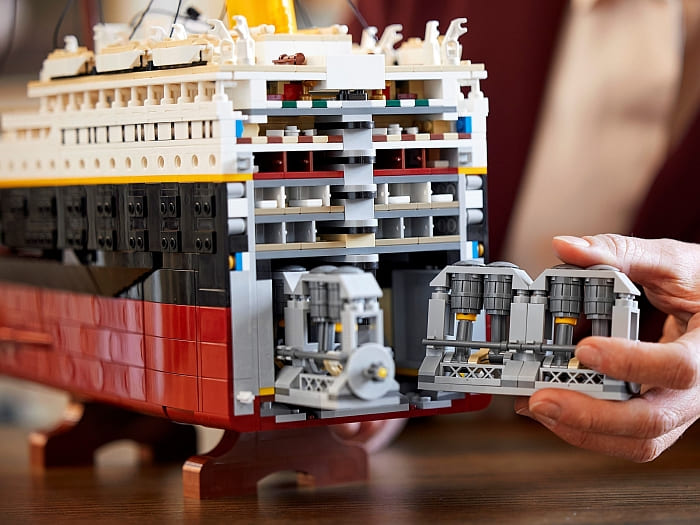
Inside each box, you know you will be building one-third of the ship. The bow, the mid-ship, and the stern are clearly shown on their accompanying box. However, as you build each boxed section, the instructions will split the third you are working on in half again.
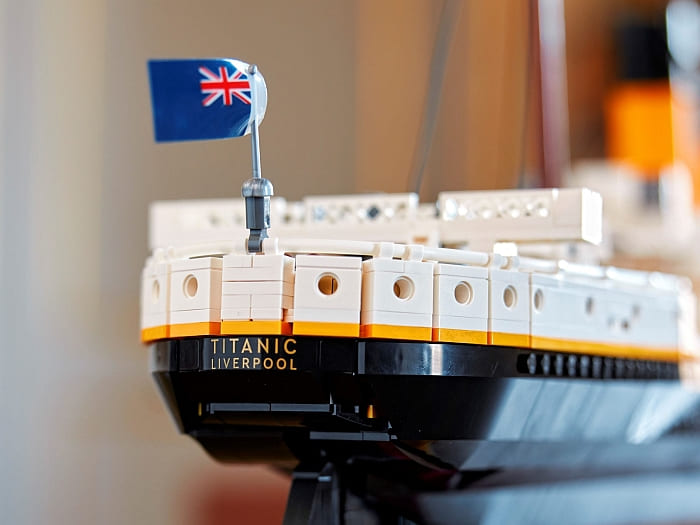
Once you build both halves, you will then get to seam them together, thus completing the third of the ship you have in front of you. The thing is, they do such a great job bringing the two halves together it is impossible to really see where that division even is if you didn’t build it yourself.
The end result is that you actually build six sections of a ship in the build process, making the experience extremely manageable. It also leads to an element of awe when you begin to put these sections together and realize just how large this model truly is.
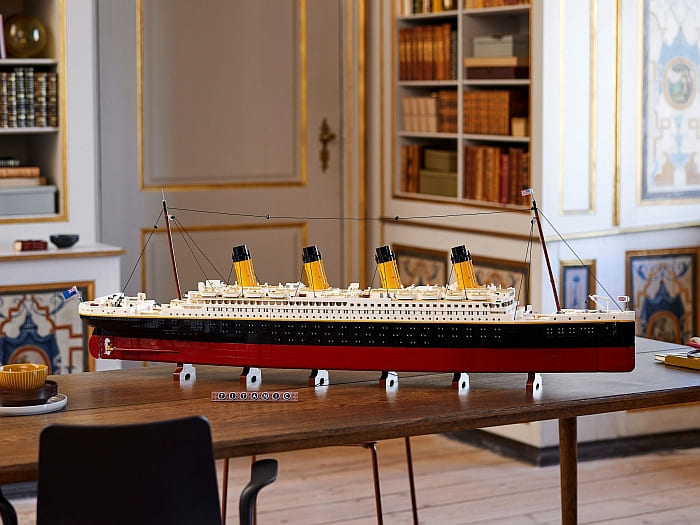
It is also important to note that when I built the Millennium Falcon, I ended up with all kinds of neck and hand pain. It was a very intense build. I didn’t experience any of that with the Titanic. I think this is partly thanks to the straightforwardness of the model’s design, meaning it’s pretty clear where parts go, as well as its organization. I had so many opportunities that felt like good stopping points that I didn’t feel pressured into going further than my body was up for. Figured this might be good to mention for the older builders out there.
LEGO TITANIC – BUILDING HARDPOINTS
It is rare to have a model be this long with this much weight involved. Therefore, I wanted to touch on a building technique I don’t normally get to talk about, outside large personal creations. Namely, the concept of creating hardpoints.
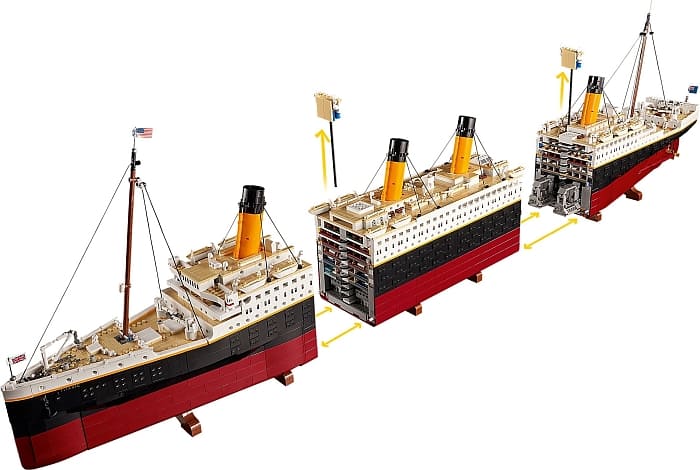
I learned the hard way that if you have a massive creation, make sure it can come apart in smaller modular sections. Trying to keep a model together in one massive piece is a recipe for disaster. This is where hardpoints come in handy.
A hardpoint is nothing more than a point in your model that will hold the majority of the stress when the modular sections are connected together. Honestly, I’ve done this wrong so many times because I didn’t plan my hardpoints correctly.
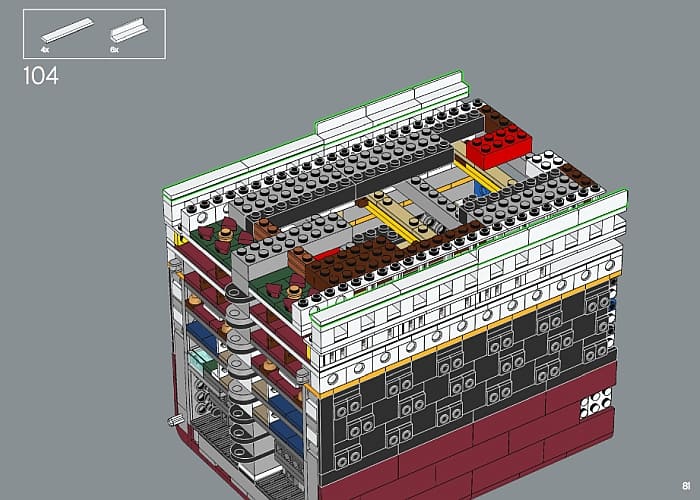
There are two main criteria you want to cover when deciding where and how a hardpoint shall be engineered. First, make sure that the connection points are tied into the main structure of the model. In the case of the Titanic, you’ll have a series of pinholes that will hold an axle. All the pinholes are built into a fairly plain wall that connects into the rest of the superstructure in several key struts. LEGO has turned these wall sections into a keystone of the stability of large sections of the ship. So, in many respects, they are the spines of the model.
The other criteria is to have as many connection points as possible to hold the load of whatever you are connecting. As mentioned before, LEGO uses an axle to seam two sections together. This axle passes through over a dozen pinholes.
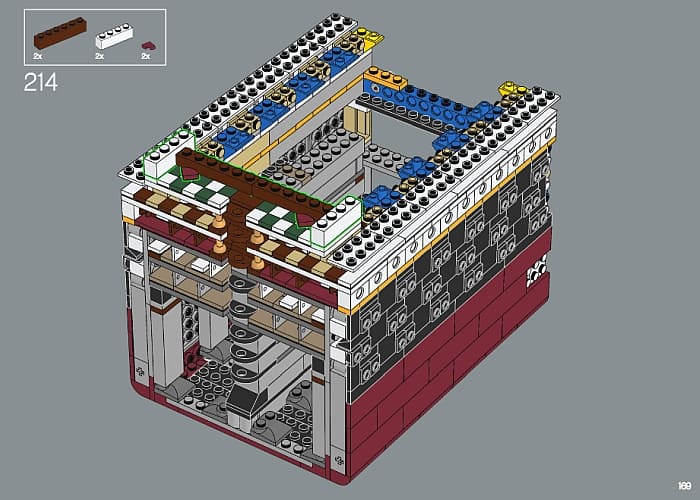
By spreading the load like this, each pinhole has less stress placed upon it. The same principle works in surface area. If you have a boulder, one person may have a tough time getting it to roll. But if you shape it like a cylinder on its side and get more people to push on it the job becomes easier.
This is the point where I usually failed. I’d make a connection tied into a main wall, then have only two points for connection. When I took the model apart, I’d usually end up with one connector ripping out of one side or the other.
As a side note. LEGO designers also use other connection types in addition to the hardpoint to help stabilize the model further. Again, when you’re talking about a model of this size, redundant connection points are very useful. Additionally, each of these connections is done in a slightly different style. One style is a clip and bar, while the other is an axle fitting into an axle hole. Varying your connections like this is good since each one is strong against a specific type of stress. As they say, more hands make easy work.
LEGO TITANIC – FINAL THOUGHTS
Based on its price ($629.99) and size (54 inches long, 18 inches tall, and 7 inches wide), the #10294 LEGO Creator Expert Titanic is definitely a niche model. With that said, I think this model does open up to some new markets. Fans of historical events, nautical buffs, or mega fans of the movie Titanic will be captivated by this set. Honestly, I can’t think of another model that has gone to this level for those audiences.
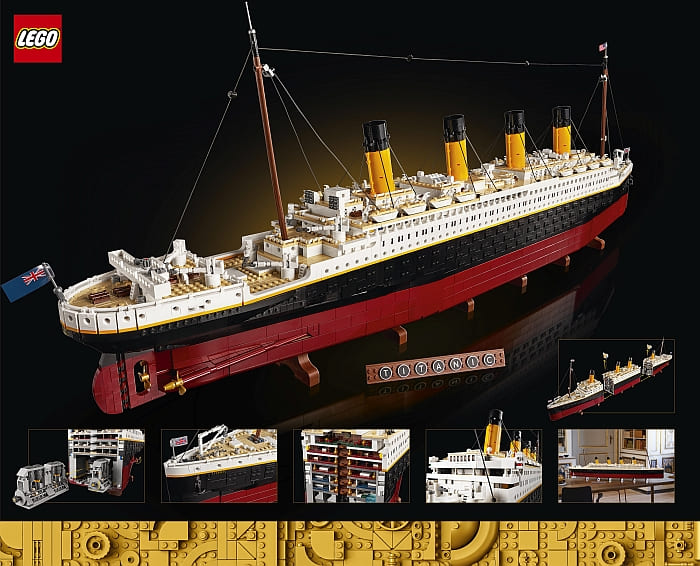
Historical buffs might have looked into some of the architectural offerings by LEGO. However, the Titanic was an event. It was a hallmark in human engineering for its time. It attracted the world’s most influential people for its passengers. And the circumstances of its sinking made it a historical lesson humanity won’t soon forget.
As for the nautical fans, the closest models all have more play surrounding them. Whether it be police boats, fireboats, cargo ships, or even pirate ships, all water-going vessels have had a less serious bent to them. Though I will say, pirate ships have come pretty close to giving nautical fans something to sink their teeth into. This is probably why we have so many fans creating massive ships. Though the Titanic does bring us into a whole new era of sea travel.
As for the fans of the movie, well, it is the Titanic. I guess the only downside for them is that we don’t get the characters from the film. But, boy this makes a crazy cool piece to have upon a mantle or shelf. Though you really do need to be a big fan of the movie to buy this.
As for me personally, I was thrilled to hear my dad say it would be a cool set to have. To my knowledge, he’s never said that about any model I’ve built. And believe me, I’ve built some pretty amazing sets. So, after the Titanic makes it to a few shows for my LUG (LEGO User Group), my father is getting this model as his first official LEGO set!
In the video above, I summarize my thoughts on the #10294 LEGO Creator Expert Titanic,and if you’re interested, you can get it at the LEGO Creator Expert section of the Online LEGO Shop.
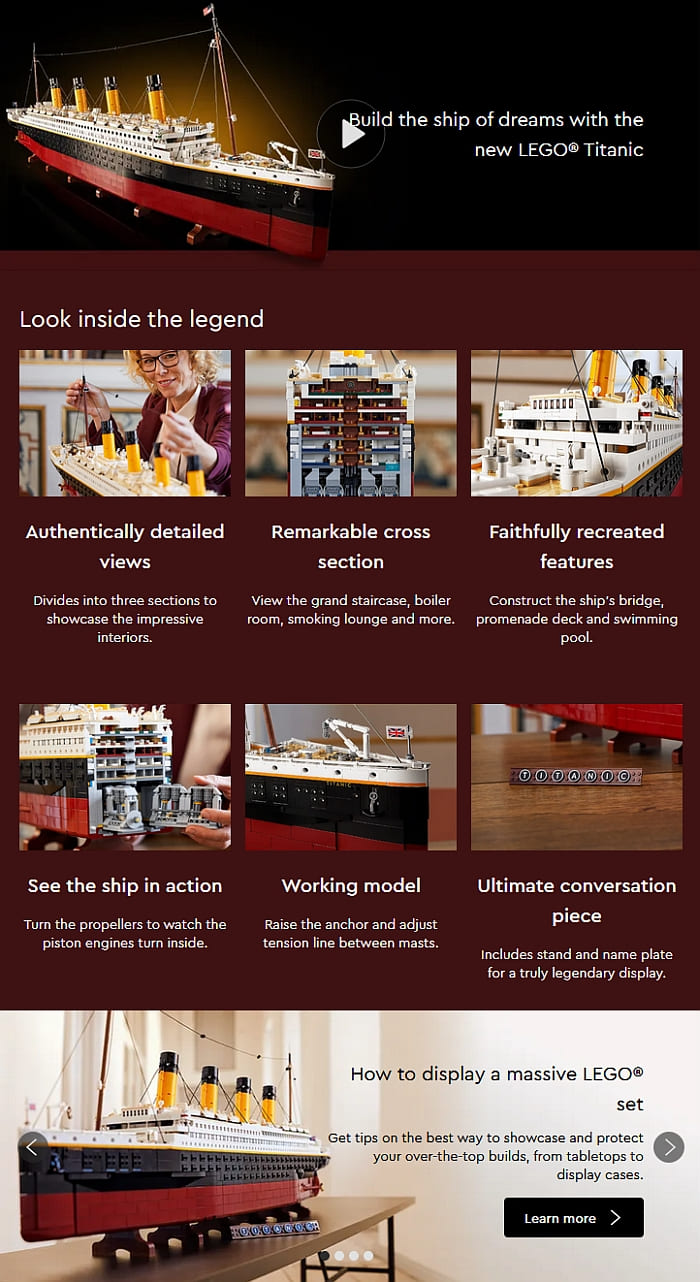 What do you think? How do you like the LEGO Titanic? Do you have it already? Or are you planning to get it? Feel free to share your thoughts and discuss in the comment section below!
What do you think? How do you like the LEGO Titanic? Do you have it already? Or are you planning to get it? Feel free to share your thoughts and discuss in the comment section below!
And you might also like to check out the following related posts:












An amazing set! I don’t know if I will ever own it, but it’s beautiful!
Great review. Thank you. This set would look great in a museum.
Great review! I don’t think I’ll ever own this, i simply do not have the space. It is something I would build and then have to put in a box for storage. Or perhaps donate it to someone for display?
It’s incredible that lego is making sets like this nowadays. Is there anything you wish was done differently? Or do you feel the set is perfect?
Great review and video. Thank you. Is it possible to pick up the entire ship at once? Or do you always have to take it apart into three sections when you want to life it?
Is that water drop on the fifth bag indicates that the parts in that bag build the section where the ship was hit? It would be an interesting easter egg.
Thanks for a great insight into this magnificent model.
I received the Saturn V 92176 set for Xmas and thoroughly enjoyed building it. This was my first adult Lego build and must admit that I’ve caught the bug!
Very insightful textual & video review.
I’ve patiently been waiting out several of Legos restocking delays which recently
permitted me to place an order.
My Titanic is ordered, paid for & currently e route.
Thank you from Cape May, NJ
Hey, Tom! Have fun building! 🙂